
There’s this idea that healthy foods are expensive. But healthy doesn’t necessarily mean expensive. In fact, that idea is really a myth.
In a recent study, researchers at Vanderbilt University found “that consumers do subscribe to a general lay theory that healthy = expensive despite the fact that this relationship is unlikely to be true in all product categories and contexts,” wrote associate professor Kelly Haws and her co-authors in a paper recently accepted for publication by the Journal of Consumer Research.
For seniors, who are often already dealing with financial hardships due to increasing health care and housing costs combined with decreasing income, this incorrect price bias can lead them to avoiding healthier options.
Fortunately, not only are healthy foods affordable, but there are also many resources for seniors and senior nutrition assistance program that empower older adults to buy nutritional foods to help stay healthy.
If you want to eat healthy on a budget, here are three tips and programs that can support you in improving your nutrition and helping you feel your best.
Try Making Low-cost Recipes
Before making a grocery list, write down meals you want to make this week. Buying for the week means you’ll make fewer shopping trips and buy only the items you need. Start by looking in your freezer, cabinets, and refrigerator and making a note of what you already have on hand. Then find new ideas for healthy and low-cost meals based on what you have on hand, foods your family enjoys, and foods that are healthy buys.
Here’s a sample of a healthy and budget-friendly recipe for chicken stir-fry from What’s Cooking? USDA Mixing Bowl.
Chicken Stir-Fry
Ingredients
- 2 tablespoons vegetable oil
- ½ cup carrots (peeled, sliced thinly, drained)
- ½ cup celery (sliced thin)
- ¼ cup onion (cut into strips)
- 1 green pepper (cut into strips)
- 1 tablespoon garlic (finely chopped)
- 1 tablespoon ginger (finely chopped, optional)
- 1 pound cooked chicken (skin removed, sliced into strips)
- ½ teaspoon sugar
- 3 tablespoons soy sauce (optional)
- 3 cups cooked brown rice
Directions
Heat a large pan with vegetable oil over high heat. Add vegetables and garlic to the hot pan. Stir until garlic is slightly brown. If using ginger, add that, too. Add the chicken and sugar to the pan. If using soy sauce, add that, too. Stir the food for about 1 minute in the pan. Serve with steamed rice.
Create a Grocery Game Plan
It’s hard to say no to Frosted Flakes when the cereal box is staring you back in the face. Instead of wandering the aisles of the grocery store looking for what you need, make a plan before heading to the store so you stay organized, save money — and choose healthy options.
To save more once you’re at the store, you can use coupons, but only for items that you know you’ll use. Instead, rely more on your local grocery store’s sales flyer. Sales flyers are usually released mid-week and can be found at the store’s entrance, in the newspaper, or on their website. For more savings, opt for store brands, which often cost less than name brands.
See If You’re Eligible for Food & Nutrition Programs
You may be eligible for senior nutrition assistance programs that give you a cash benefit. You can also get help from food and meal assistance programs, which deliver healthy food and meals to your home or at various community locations.
Popular programs include:
Senior Farmers’ Market Nutrition Program
These provide low-income seniors with coupons that can be exchanged for eligible foods (fruits, vegetables, honey, and fresh-cut herbs) at farmers’ markets, roadside stands, and community supported agriculture programs.
Home-delivered Meals
Sometimes known as Meals on Wheels, these provide seniors with nutritious lunches that are delivered weekdays between 10 a.m. and 2 p.m. Meals on Wheels also offers group meal sites, sometimes called congregate sites, where seniors can come for food and fellowship.
Commodity Supplemental Food Program
This improves the health of low-income seniors by supplementing their diets with nutritious USDA Foods.
For tips on how to prepare healthy meals, download our eBook Nutritious Delicious: A Guide to Highgate’s Unique Dining Program.





